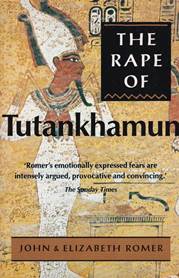
There is a terrible threat hanging over the Valley of the Kings and the Tomb of Tutankhamun at its centre. More damage has occurred there in the past 100 years than in the previous 4,000.
Further damage is threatened now by the work of modern archaeologists and Egyptologists. Unlike whales or rain forests, ancient monuments cannot mend or reproduce themselves. The past is finite, and we look to specialists to observe the state of our heritage and tell the world when it is endangered, yet in the Valley of the Kings and at other Egyptian sites, foreign
specialists remain silent.
The Rape of Tutankhamun tells of an uncaring international profession that remains aloof from the problems that face the Egyptian tombs and temples. In a chapter entitled ‘Study and Steal’, the authors explain the historical origins of this sad situation. The Rape of Tutankhamun also tells of the modern, multinational business surrounding Egyptology which, with barely a word of protest from the specialists, is engaged in exploiting and trading in the relics of an ancient civilization that is disappearing before our eyes. Of the tens of millions earned by ancient Egypt in the West, barely one per cent has gone back into its conservation on site.
The Rape of Tutankhamun underlines the importance that such magnificent relics have for all of us and for world civilization. There is a perennial danger of flash flooding in the Valley of the Kings, a catastrophe from which the royal tombs are completely unprotected. Mass tourism carries its own problems; imagine three million tourists a year pouring into Tutankhamun’s tomb, a chamber the size of a sitting room. Yet these same visitors have often travelled thousands of miles for the privilege of seeing ancient Egypt; they care about its continuing survival and are concerned for the damage that they can see all around them. Scandalously, neither the western specialists nor the media have begun to tell them the true, modern story about ancient Egypt; that it is in danger of disappearing.
The message they have passed on to the public is that ancient things are there for our exploitation and amusement. When challenged about the present situation, most Egyptologists — and many senior members of the profession have been interviewed especially for The Rape of Tutankhamun — publicly trot out the wellworn myths of tourism or the ruinous effects of the High Dam about which they can do nothing. Privately they blame Egyptian officialdom. In reality, the Egyptian officials are the only people who concern themselves, day-by- day, with the salvation of the monuments. Their constant requests for cooperation in what is now the high-tech industry of conservation are, with few exceptions, ignored. The Rape of Tutankhamun exposes the convenient mythology that has grown up around the real problems of conservation. It also offers some solutions to the problems.

